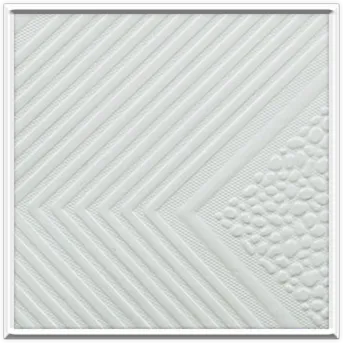11 月 . 02, 2024 08:59 Back to list
grid ceiling tiles material
Exploring the Material Choices for Grid Ceiling Tiles
In the realm of interior design, one often underappreciated element is the ceiling. While floors and walls take center stage, ceilings significantly influence a room's ambiance and acoustics. Among the various ceiling options, grid ceiling tiles have become increasingly popular due to their versatility and practicality. Understanding the different materials used for these tiles can help designers and homeowners make informed decisions that enhance both aesthetics and function.
What Are Grid Ceiling Tiles?
Grid ceiling tiles, commonly referred to as suspended or drop ceilings, consist of a framework of metal grids that support lightweight tiles. These systems provide a functional space between the original ceiling and the tiles, allowing for easy access to plumbing, wiring, and other utilities. Beyond utility, grid ceilings play a crucial role in insulation, acoustics, and even fire resistance.
Material Options for Grid Ceiling Tiles
1. Mineral Fiber One of the most prevalent materials for grid ceiling tiles is mineral fiber. These tiles are known for their excellent acoustic properties, making them ideal for offices, schools, and other public spaces where sound control is essential. Mineral fiber tiles are typically made from a blend of natural and synthetic materials, providing both durability and ease of maintenance. Their lightweight nature allows for straightforward installation and replacement.
grid ceiling tiles material

2. Gypsum Board Gypsum ceiling tiles offer a smooth, finished appearance that is favored in more formal settings. They provide superior fire resistance, making them an excellent choice for commercial buildings and residential spaces requiring heightened safety measures. Gypsum tiles can be painted or finished in various textures, allowing for further customization of interior aesthetics.
3. Metal For a contemporary look, metal grid ceiling tiles are increasingly popular. They offer a sleek, modern aesthetic and are incredibly durable. Available in various finishes such as aluminum, tin, or stainless steel, metal tiles resist wear and tear and are ideal for high-traffic areas. Additionally, they reflect light, contributing to a brighter and more open atmosphere.
4. PVC and Vinyl Polyvinyl chloride (PVC) and vinyl tiles present another option, particularly in spaces that encounter moisture, such as bathrooms and kitchens. These materials are waterproof and resistant to mold and mildew, making them practical for humid environments. PVC tiles come in various colors and patterns, offering a decorative touch while maintaining functionality.
5. Wood For a warmer, more natural feel, wood tiles can be integrated into grid ceiling systems. These tiles may be made from plywood or other engineered wood materials and can create a cozy atmosphere in both residential and commercial spaces. However, wood is typically more expensive and may require additional treatment to enhance durability and fire resistance.
Conclusion
The choice of material for grid ceiling tiles is essential in achieving the desired look and functionality of a space. Understanding the unique properties of mineral fiber, gypsum, metal, PVC, and wood can guide designers and homeowners in selecting the best option for their needs. Whether the goal is to enhance acoustics, improve aesthetics, or ensure fire safety, each material offers distinct advantages that can elevate the overall design of a room. Investing time in selecting the right ceiling tiles can result in a space that is both beautiful and functional, enhancing the quality of life for its inhabitants.
-
Revolutionizing Interior Design with Ceilings t grid Suspended SystemNewsOct.29,2024
-
Revolutionizing Ceiling Design with ceiling access panel with Gypsum Tile WaterproofNewsOct.29,2024
-
Revolutionizing Interior Design with PVC Gypsum Ceiling: A Comprehensive GuideNewsOct.29,2024
-
Elevating Interior Design with High quality Mineral Fiber Ceiling TilesNewsOct.29,2024
-
Revolutionizing Interior Design with PVC Gypsum Ceiling: A Comprehensive GuideNewsOct.29,2024
-
Elevating Interior Design with High-Quality Mineral Fiber Ceiling Tiles: A Comprehensive GuideNewsOct.29,2024







